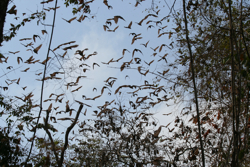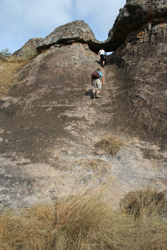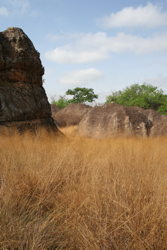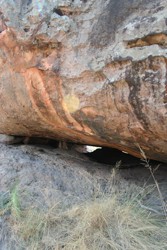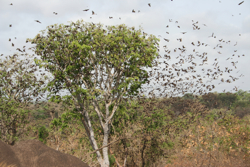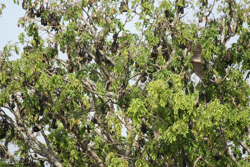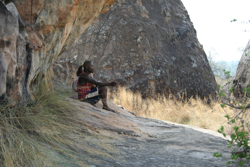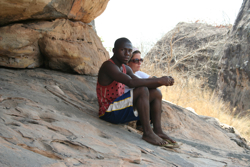The breakfast coffee is an old standby—two cups, two tubes of instant coffee granules, and a thermos of hot water. 2GHc. We're only half way down it when Emanuel reappears with the car, which has obviously been washed and polished both inside and out. I asked him about it. He did not say anything about the expectations of a limo service. Instead he said "if you can afford a new car, you can afford to pay someone to clean it."
Practically since we started out on the trip, Alexis has fretted endlessly about an embassy job she had been offered. The problem being the work permit this required, and the palm-greasing and string-pulling that the permit required. Her indecision, phone calls, questions and ever more phone calls drove all of us crazy, including her. Overnight, she has finally made her mind up about what to do: she will return to Accra to work on her work permit, and meet us back in Brekumansu. A number of options for making that happen are bandied around, but I for one am not up for any that involve Wayne and I losing the car. So she will take the overnight bus this evening, therefore the first order of business today is to get her a ticket on the bus. Of course this takes longer than anticipated, so after 20 minutes we're still within 100 yards of the hotel. But finally we're off, and since the first stop is only 15km away, in another 20 minutes we're in the little town of Tanoboase, where we have to turn off the main road onto what I would normally describe as a dirt track, except that that is really all the main road was too.
A mile or so down the road we're clearly in the right spot. We can see a large rocky outcrop, but what has really drawn our attention to the area is a cloud of fruit bats so dense it looks more like starlings. There's a small layby but no signs, no people, no nothin'. We drive on, but eventually convince ourselves that this must have been the spot, and we turn around and go back. Still nothing. Finally, Wayne asks a couple of workers for advice, and they send us all the way back to town. As soon as we pull up at the junction, a young man steps into the street and approaches the driver's window. He apologies for not managing to get our attention the first time we came through, but he assumes we're here to see Tano Sacred Grove, and he is Roger, who will be our guide. But first we need to turn around, pull over, park, and meet the village chief/head of tourism/his boss. We do as we're told, exchange pleasantries with the chief, and then Roger gets in the car with us to lead us back to the exact spot we'd identified earlier. It's a perfect shady dell to leave the car, and Emanuel prepares for a nap as the rest of us head into the forest.
As you hike along the nature trails, you will observe a variety of plant, tree, bird, and butterfly species. So says the pamphlet the village elder gave me. In reality, you will be hard-pressed to pay attention to any of these, because the rain pattering on the leaves of the trees is not rain, it is (fruit) bat urine. I'm so glad I'm wearing my hat, with it's wide brim. There are millions, even tens of millions of them. They are literally sky-darkening in numbers. One lone little coconut palm which doesn't look like it could hold more than a couple of them suddenly unleashes a couple of hundred. More open-branched trees seem to have as many bats as they have leaves. The guide further claims that the sanctuary protects a variety of mammals and birds. Wayne claims we saw a palmnut vulture soaring high overhead, but all I remember was these bird-mammals, and if that's all he saw in the couple of hours we were there, then indeed there was a dearth.
Tano Sacred Grove is nestled within a semi-deciduous forest and encloses a cluster of striking sandstone rock formations. The pamphlet goes on to say that "an easy climb up sandstone rocks leads to a panoramic overlook that was used during the Ashanti-Bono wars." Bradt again proves its worth by claiming instead that "assuming you're reasonably fit and fearless a hike up the steep rock surfaces to the top of the escarpment [leads to] a stunning lookout point used during the 18th century Ashanti-Bono Wars."
The climb was short enough but up about a 60° incline with no handholds or footholds. I was glad it was not wet. But it was indeed well worth the trip. The rocky outcrops were stunning, a giants pile of pebbles,twenty to 50 feet high. Roger lead us in and out, over and under the various formations. One very steep climb up 15 feet or so did actually have a strand of rope to help up the last few feet whereupon we squeezed under a huge boulder being held a couple of feet off the ground. I was a source of much amusement as I squirmed through on my knees and elbows, while my hands were full of the hardware that ordinarily was hanging around my neck, but now of course would otherwise have been dragging on the ground. A beautiful vista of tall grasses, sandstone outcrops, and the tops of the trees below was a welcome reward, and we sat for several minutes. Something panicked the bats in one of the nearby trees, and the tree seemed to explode like a firework as the ball of bats enlarged and then dissipated as several thousand bats made their escape.
Tano was one of the earliest Bono settlements. According to oral history, the Bono people emerged from a cave called Amowi hundreds of years ago and created the first centralized Akan state, originally known as the Bono-Manso kingdom, and later as the Techiman-Bono kingdom. Roger led us around to their ancient lookout—a big triangle of rock perched out on what was already a ledge. He helped Alexis up onto the triangle, and Wayne joined the two of them on the pinnacle. I had absolutely no need to see how much this improved the already splendid view across the nearby hills.
It is clear that there has been a fire, and recently. Roger explains that indeed we are lucky. The fire only got put out yesterday, and it took them two days—if we'd arrived earlier, we would not have been able to do the tour. It was not clear what their evidence was, but the villagers seem convinced that the fire was started deliberately by folks from a neighboring village. The chief bought a tanker-load of water, and the people of Tanoboase (or more accurately the women of Tanoboase) had hiked it up the hill, one basin-full at a time.
Tortoise Rock, (not mentioned in any of the other literature that I read) is very symmetrical, but I would say it was more like the pointy end of an egg rather than the shallow curved lump that a tortoise back normally acquires. But shape aside, legend has it that if warring tribes saw the rock they had to make peace. And since the warring Ashanti-Bono tribes saw it, they were forced to cease and desist. We could learn a thing or two.
The way off the rocks was much less dramatic, but suddenly I realized we were back in the surrounding forest, and almost immediately after that we were back at the car. Roger has been playing with a "ball" which I ask him about. It turns out to be the seed of a plant he can't name, very popular as a soccer ball even though it is no bigger than a large avocado stone. In fact I wonder if it is an avocado stone. But it is very round, and lighter than I expected. Souvenir number one.
Pito
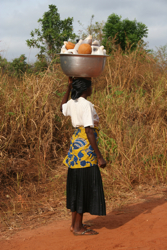 Once we're done, we have to drive Roger back into Tanoboase. In the few minutes we're in the car, I realize that somehow I have lost my pencil during all the scrambling and crawling. So when the chief is milling around where we drop Roger off, I ask him if it is possible to get a replacement in the village. He calls a girl of 6 or 7 over to us, and gives her some instructions and some money. She runs off about 15 feet then turns and asks him a question. "Do you want it sharpened?" Wow, who would have thought to ask? "Yes please, that would be great." He relays the message and girl disappears. Less than five minutes later she reappears, with the hand-sharpened pencil. The chief will not take any money for it, but I make him tell me how much it was. 10peswas. I give hive a 1GHc note and tell him it is a donation. This he accepts.
Once we're done, we have to drive Roger back into Tanoboase. In the few minutes we're in the car, I realize that somehow I have lost my pencil during all the scrambling and crawling. So when the chief is milling around where we drop Roger off, I ask him if it is possible to get a replacement in the village. He calls a girl of 6 or 7 over to us, and gives her some instructions and some money. She runs off about 15 feet then turns and asks him a question. "Do you want it sharpened?" Wow, who would have thought to ask? "Yes please, that would be great." He relays the message and girl disappears. Less than five minutes later she reappears, with the hand-sharpened pencil. The chief will not take any money for it, but I make him tell me how much it was. 10peswas. I give hive a 1GHc note and tell him it is a donation. This he accepts.
The road to Tano is a short-cut to the monkey sanctuary, so Emanuel has turned the car around again as we wait, and now we head back the way we just came. We haven't gotten much further than the grove again when we come across a woman walking along the road with her head-basin piled high with plastic containers all frothing at the mouth (none have tops). "Pito!" Wayne exclaims. "We stop?" Emanuel asks (he's getting the hang of this) "Oh yeah!" Wayne and Richard in unison. The basin is too heavy for her to lift down on her own, so we help lower it to the ground. Emanuel helps with the negotiation. We can, of course, buy some, but we can't buy one of the containers (plastic is precious we now know.) A "serving" is 10peswas (10 cents) which seems affordable, and we agree.
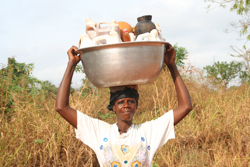 A second later we realize we've made a fatal error. I look at Wayne who just shakes his head. The woman pours our purchase into one of her calabashes. There is no way the pito contains enough alcohol to kill what flora or fauna might be lurking in the bowl, which has been sitting in the sun for hours, and who knows how many other people have drunk from it already. I turn to Alexis and murmur under my breath: "We're going to have to drink this aren't we?" "Ab-so-lutely" she says slowly. I take a couple of draughts. Wayne does the same. In a stroke of genius, he then offers the bowl to Emanuel who seems to have understood what is going on, because he takes the calabash and carefully pours the remaining liquid down his throat, and hands the empty bowl back to the woman. It was interesting stuff, sweet as mead, but with scrumpy's tang of vinegar too. Served at a temperature perfect for growing anything that was living in it. Honor satisfied, she puts the calabash back in the basin, and we help her hoist it aloft once more.
A second later we realize we've made a fatal error. I look at Wayne who just shakes his head. The woman pours our purchase into one of her calabashes. There is no way the pito contains enough alcohol to kill what flora or fauna might be lurking in the bowl, which has been sitting in the sun for hours, and who knows how many other people have drunk from it already. I turn to Alexis and murmur under my breath: "We're going to have to drink this aren't we?" "Ab-so-lutely" she says slowly. I take a couple of draughts. Wayne does the same. In a stroke of genius, he then offers the bowl to Emanuel who seems to have understood what is going on, because he takes the calabash and carefully pours the remaining liquid down his throat, and hands the empty bowl back to the woman. It was interesting stuff, sweet as mead, but with scrumpy's tang of vinegar too. Served at a temperature perfect for growing anything that was living in it. Honor satisfied, she puts the calabash back in the basin, and we help her hoist it aloft once more.
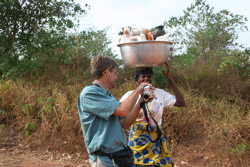 Now we've paid for her wares, this seems like a good opportunity to ask if we can take her photograph. She's puzzled by the request, but she agrees. In his second smart move in five minutes (a record, even for Wayne) he shields the sun from the preview window on his camera so she can see the picture. She is truly amazed, and laughs out loud. We speculate later, given how few mirrors we've seen, that it is possible that this is the first time she's ever seen herself. In any case, he clearly made her day, so I showed her my efforts too, and we silently vow to use this trick again. We get back into the car and Wayne says "I think we should start taking the Cipro prophylactically". It seems like a good idea, given how healthy we've been until now, and given how much more effective it will be while we can still keep it down, but of course the problem is that we don't have a lot of it. Even more alarmingly, when we go to pool our resources, the pills are not the same. Wayne's Cipro looks just like the malaria meds we're taking. Double %^&@. We have plenty of that. Back to the now worsened Cipro dilemma. There is a danger that if we take it now, and then really need it later, there will not be enough to go around. A compromise is reached. We'll take one right way, and if the symptoms have not started by the morning, we'll stop again.
Now we've paid for her wares, this seems like a good opportunity to ask if we can take her photograph. She's puzzled by the request, but she agrees. In his second smart move in five minutes (a record, even for Wayne) he shields the sun from the preview window on his camera so she can see the picture. She is truly amazed, and laughs out loud. We speculate later, given how few mirrors we've seen, that it is possible that this is the first time she's ever seen herself. In any case, he clearly made her day, so I showed her my efforts too, and we silently vow to use this trick again. We get back into the car and Wayne says "I think we should start taking the Cipro prophylactically". It seems like a good idea, given how healthy we've been until now, and given how much more effective it will be while we can still keep it down, but of course the problem is that we don't have a lot of it. Even more alarmingly, when we go to pool our resources, the pills are not the same. Wayne's Cipro looks just like the malaria meds we're taking. Double %^&@. We have plenty of that. Back to the now worsened Cipro dilemma. There is a danger that if we take it now, and then really need it later, there will not be enough to go around. A compromise is reached. We'll take one right way, and if the symptoms have not started by the morning, we'll stop again.
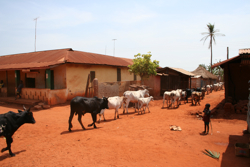 The map makes the short-cut look like a straight shot. But as Murphy once observed, "a short-cut is the longest distance between two points." The straight shot contained any number of T-junctions and other places where the choices were between this dirt track and that dirt track. There were never any street signs, village names or any other kind of hint. Once, as far as I could tell, we made a choice based solely on the fact that the herd of cattle in front of us took the other option. But Emanuel finally threaded us through to the main road, and since we never turned around, I have to assume he was using navigational aids that were just too subtle for me to notice.
The map makes the short-cut look like a straight shot. But as Murphy once observed, "a short-cut is the longest distance between two points." The straight shot contained any number of T-junctions and other places where the choices were between this dirt track and that dirt track. There were never any street signs, village names or any other kind of hint. Once, as far as I could tell, we made a choice based solely on the fact that the herd of cattle in front of us took the other option. But Emanuel finally threaded us through to the main road, and since we never turned around, I have to assume he was using navigational aids that were just too subtle for me to notice.



